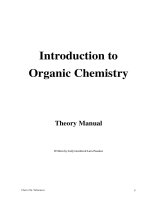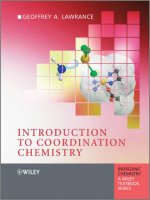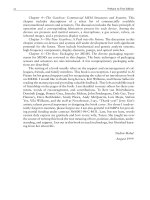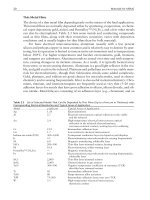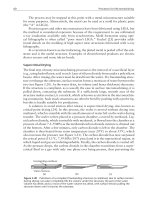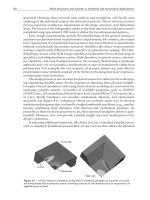INTRODUCTION TO INORGANIC CHEMISTRY KEY IDEAS AND THEIR EXPERIMENTAL BASIS
Bạn đang xem bản rút gọn của tài liệu. Xem và tải ngay bản đầy đủ của tài liệu tại đây (4.71 MB, 177 trang )
PETER G. NELSON
INTRODUCTION TO INORGANIC
CHEMISTRY
KEY IDEAS AND THEIR EXPERIMENTAL BASIS
DOWNLOAD FREE TEXTBOOKS AT
BOOKBOON.COM
NO REGISTRATION NEEDED
Peter G. Nelson
Introduction to Inorganic Chemistry
Key ideas and their experimental basis
Download free ebooks at bookboon.com
2
Introduction to Inorganic Chemistry: Key ideas and their experimental basis
© 2011 Peter G. Nelson & Ventus Publishing ApS
ISBN 978-87-7681-732-9
Download free ebooks at bookboon.com
3
Contents
Introduction to Inorganic Chemistry
Contents
1
Introduction
Chemistry
Inorganic Chemistry
This course
Broader context
Further reading
10
10
10
10
11
11
2
2.1
2.2
2.3
The relative importance of different elements
The relative abundance of different elements
The relative consumption of different elements
Elements sought after from very low-grade ores
Further reading
12
12
14
14
15
3
3.1
3.2
3.3
3.4
Classiication of elements into metals and nonmetals
Types of element
Assignment of elements to classes
Volatilities of metals and nonmetals
Chemical properties of metals and nonmetals
16
16
19
20
20
4
4.1
4.2
Binary compounds
General classiication of compounds
Limiting types of binary compound
22
22
22
Please click the advert
WHAT‘S MISSING IN THIS EQUATION?
You could be one of our future talents
MAERSK INTERNATIONAL TECHNOLOGY & SCIENCE PROGRAMME
Are you about to graduate as an engineer or geoscientist? Or have you already graduated?
If so, there may be an exciting future for you with A.P. Moller - Maersk.
www.maersk.com/mitas
Download free ebooks at bookboon.com
4
Contents
Introduction to Inorganic Chemistry
Metallic compounds
Nonmetallic compounds
Salt-like compounds
Intermediate types of binary compound
Further reading
22
25
26
29
30
5
5.1
5.2
5.3
5.4
On the nature of the limiting types of binary compound
Nonmetallic compounds
Salt-like compounds
Metallic compounds
Limiting types of chemical bond
Further reading
31
31
38
40
43
46
6
6.1
6.2
6.3
6.4
Types of formula
Empirical formulae
Molecular formulae
Structural formulae
Geometrical formulae
47
47
47
47
50
7
7.1
7.2
7.3
7.4
Classiication of elements according to the electrochemical series
Electrical and chemical series
The electrochemical series
Electronegativity
Polar numbers
51
51
55
57
59
Please click the advert
4.3
4.4
4.5
4.6
Download free ebooks at bookboon.com
5
Contents
Introduction to Inorganic Chemistry
Nomenclature of binary compounds
Further reading
61
63
8
8.1
8.2
8.3
8.4
8.5
Valency
Ordinary valency
Electrovalency
Covalency
Applicability of the three kinds of valency (V, E, and C)
Extension
Table: Principal valencies of some important elements
64
64
66
68
68
71
73
9
9.1
9.2
9.3
9.4
Pseudo-binary compounds
Introduction
On the nature of pseudo-binary compounds
Some important radicals
Nomenclature
75
75
77
78
79
10
10.1
10.2
10.3
10.4
10.5
The Periodic Table
The Periodic Law
Nomenclature
Use of the table
General features
A better form of table
Further reading
81
81
84
87
87
89
90
Please click the advert
7.5
www.job.oticon.dk
Download free ebooks at bookboon.com
6
Contents
Introduction to Inorganic Chemistry
11
Interpretation of main-group valencies in terms of a simple model of
main-group atoms
Basic theory
Reinement of model in the light of the quantum theory of atoms
The dative bond
Isoelectronic principle
Transition elements
Shapes of molecules
Further reading
91
91
93
95
98
100
100
101
12
12.1
12.2
12.3
Compounds of higher order than two
Limiting types
Metallic compounds
Nonmetallic and salt-like compounds
102
102
102
102
13
13.1
13.2
13.3
13.4
13.5
Coordination compounds
Basic theory
Terminology of coordination compounds
Nomenclature of coordination compounds
Bonding in coordination compounds
Nonclassical coordination compounds
Further reading
106
106
110
112
113
118
119
Please click the advert
11.1
11.2
11.3
11.4
11.5
11.6
Download free ebooks at bookboon.com
7
Contents
Introduction to Inorganic Chemistry
14
14.1
14.2
Loose compounds and solutions
Solutions
Loose compounds
120
120
122
15
15.1
15.2
Types of chemical reaction
General types
Some special types of reaction
126
126
129
16
16.1
16.2
16.3
16.4
16.5
16.6
16.7
16.8
Acids, bases, and salts
Classical conception
Stoicheiometric conception
Electrolytic conception
Equations for acid-base reactions
Further aspects
Lowry-Brønsted conception of acids and bases
Solvent-system conception of acids and bases
Other conceptions of acids and bases
132
132
136
137
139
141
143
146
147
17
17.1
17.2
17.3
Oxidation and reduction
Basic theory
Half equations
On the balancing of equations for redox reactions
148
148
150
153
18
Further study
157
Turning a challenge into a learning curve.
Just another day at the office for a high performer.
Please click the advert
Accenture Boot Camp – your toughest test yet
Choose Accenture for a career where the variety of opportunities and challenges allows you to make a
difference every day. A place where you can develop your potential and grow professionally, working
alongside talented colleagues. The only place where you can learn from our unrivalled experience, while
helping our global clients achieve high performance. If this is your idea of a typical working day, then
Accenture is the place to be.
It all starts at Boot Camp. It’s 48 hours
that will stimulate your mind and
enhance your career prospects. You’ll
spend time with other students, top
Accenture Consultants and special
guests. An inspirational two days
packed with intellectual challenges
and activities designed to let you
discover what it really means to be a
high performer in business. We can’t
tell you everything about Boot Camp,
but expect a fast-paced, exhilarating
and intense learning experience.
It could be your toughest test yet,
which is exactly what will make it
your biggest opportunity.
Find out more and apply online.
Visit accenture.com/bootcamp
Download free ebooks at bookboon.com
8
Introduction to Inorganic Chemistry
Contents
Appendix 1 Hints and answers
A1.1 Answers to questions and exercises, Chapters 1 - 5
A1.2 Hints for exercises, Section 5.2
A1.3 Answers to questions and exercises, Chapters 6 - 9
A1.4 Answers to questions and exercises, Chapters 10 - 12
A1.5 Answers to questions and exercises, Chapters 13 - 18
158
158
161
162
166
168
Appendix 2 Pictures of structures
171
Appendix 3
174
Appendix 4
175
Appendix 5
177
Download free ebooks at bookboon.com
9
Introduction to Inorganic Chemistry
Introduction
1 Introduction
Chemistry
Chemistry comprises two related but distinct activities:
(i) the quest for an understanding of matter and material change,
(ii) the utilization of material change for human ends.
Ideally, the first activity provides the necessary know-how for the pursuit of the second, but in practice,
the help it can give is only partial, and the second activity has to fall back on trial and error techniques in
order to achieve its ends. This means that a good chemist is one who not only has a mastery of chemical
theory, but also a good knowledge of chemical facts. With such a knowledge, he can direct a trial and
error approach to practical problems in the most promising directions.
Inorganic Chemistry
Organic chemistry is usually defined as the chemistry of compounds of carbon, inorganic chemistry being
then the chemistry of all the other elements. This distinction is not a completely satisfactory one, however,
since there are many compounds of carbon that are quite different from those studied by organic chemists
(e.g. tungsten carbide, used for tipping cutting tools) and there are many compounds of other elements that
are very similar to those studied under organic chemistry (e.g. the silicon analogues of the hydrocarbons).
It is best, therefore, to think of inorganic chemistry as the chemistry of all the elements, with organic
chemistry as being a more detailed study of certain important aspects of one of them - viz. the
hydrocarbons and their derivatives.
Thinking of inorganic chemistry in this way brings together aspects of the chemistry of an element that
would otherwise tend to become separated. For example, alcohols and ethers are usually dealt with under
organic chemistry and are not thought of as being part of the chemistry of oxygen. Once they are, however,
they can be set alongside the other compounds of oxygen, and a relationship immediately becomes
apparent that might otherwise be lost, viz. that expressed by the formulae:
H–O–H
R–O–H
R–O–R′
This course
My aim in this course is to derive the key ideas of inorganic chemistry from chemical observations. I do
this by following the reasoning of chemists who have developed these ideas.
Many instructors take a different approach. They start with the quantum theory of atoms and molecules,
and deduce the key ideas from this. The quantum theory enables the energy of an atom or molecule to be
calculated, and the average motion of the electrons in it. With the help of modern computers, it gives
remarkably accurate results.
Download free ebooks at bookboon.com
10
Introduction to Inorganic Chemistry
Introduction
The quantum theory, however, is essentially a physical theory, developed to explain observations like the
atomic spectrum of hydrogen. Chemical ideas do not emerge from it easily. The theory is also very
mathematical. Most chemists have to accept the results of quantum-mechanical calculations on trust. My
approach avoids these problems. While I bring in the quantum theory where it is helpful, my treatment is
essentially chemical. This makes for an easier introduction to the subject, and leads, I believe, to a better
understanding of the key ideas, and the chemical thinking behind them.
Broader context
As defined above, chemistry is a very broad subject. It extends from the scientific study of substances
(“pure” chemistry) to their manufacture and use (“applied” chemistry). It requires both mental effort and
practical skill. It impacts on the world both intellectually and practically. When studying any particular
part of chemistry, this broader context needs to be kept continually in mind.
Acknowledgment
I am very grateful to my colleagues with whom I have discussed the material in this course over many
years, especially Dr. David A. Johnson, the late Dr. John R. Chipperfield, and the late Dr. B. Michael
Chadwick. John encouraged me to put the course on the internet and prepared the text for this. I dedicate
the web version to his memory.
Further reading
There are several textbooks of introductory inorganic chemistry. As these take a different approach from
me, they are best read after this course, as a complement to it. However, I shall occasionally suggest that
you look up something in a standard textbook, so it would be helpful if you had one to hand.
For a fuller discussion of the scope of chemistry, see my article:
“What is chemistry?”, Education in Chemistry, 1983, Vol. 20, pp. 122-125.
Download free ebooks at bookboon.com
11
Introduction to Inorganic Chemistry
The relative importance of different elements
2 The relative importance of different elements
From an academic point of view, all elements might be said to be equally important. The chemistry of
each has to be understood in detail if the chemistry of matter as a whole is to be understood in detail. From
the point of view of the world at large, however, the relative importance of different elements varies
widely, and some elements are little more that chemical curiosities. In a university course of inorganic
chemistry, a balance has to be struck between a uniform treatment of all of the elements, and a greater
concentration on the socially more important ones.
The question of which are the socially more important elements is to some extent a matter of opinion. A
chemist working in the plastics industry would doubtless come up with a different list from one working
in the metals industry, and someone working with agricultural chemicals would doubtless have different
ideas from someone working on ceramics. Most people would agree, however, that among the most
important elements are (i) the more abundant elements, (ii) elements that are consumed on a very large
scale, and (iii) elements that are actively sought for despite very poor resources. Data on each of these
categories are presented below.
2.1 The relative abundance of different elements
The figures below give the relative abundance of different elements in the atmosphere, the hydrosphere,
the lithosphere, and the biosphere. The figures are necessarily approximate, and slightly different values
may be found in other places. The percentages are percentages by mass - the percentage numbers of atoms
would of course be different. All abundances over 0.1% have been included. The figures reveal that some
99% of the matter in the world around us is made up of as few as 14 elements. Note, however, that many
of the remaining elements in the biosphere, despite their low concentration, are essential to its healthy
continuance.
Atmosphere
Nitrogen
75.5%
Oxygen
23.0%
Argon
1.4%
Total 99.9%
Download free ebooks at bookboon.com
12
Introduction to Inorganic Chemistry
The relative importance of different elements
Hydrosphere
Oxygen
85.8%
Hydrogen
10.7%
Chlorine
2.1%
Sodium
1.1%
Total 99.7%
Lithosphere
Oxygen
46.6%
Silicon
27.7%
Aluminum
8.1%
Iron
5.0%
Calcium
3.6%
Sodium
2.8%
Potassium
2.6%
Magnesium
2.1%
Titanium
0.4%
Total 98.9%
Biosphere
Oxygen
52.4%
Carbon
39.4%
Hydrogen
6.6%
Nitrogen
0.5%
Calcium
0.4%
Potassium
0.2%
Total 99.5%
Download free ebooks at bookboon.com
13
Introduction to Inorganic Chemistry
The relative importance of different elements
2.2 The relative consumption of different elements
The figures below give the annual world consumption of different elements, as elements and compounds,
in millions of tons. The figures vary from year to year and are necessarily approximate. Siliceous
materials and limestone used for building purposes have been excluded, and a lower limit has been set at
0.1 million tons.
Millions of tons per
year
1000-10000
100-1000
10-100
1-10
Carbon
Iron, sodium
Calcium, nitrogen, oxygen, potassium, sulfur
Aluminium, barium, chlorine, chromium, copper,
fluorine, hydrogen, lead, magnesium, manganese,
phosphorus, zinc
Boron, nickel, tin, titanium, zirconium
0.1-1
Of the 25 elements in the table, 10 are very plentiful, and appear in the first three tables of the previous
section (2.1). Of the remainder, the majority occur in relatively concentrated deposits, from which they or
their compounds can be extracted fairly easily (e.g. hydrocarbons from petroleum). For copper, lead, zinc,
nickel, and tin, demand is such that less concentrated deposits have to be worked, down to 0.5% in the
case of copper and 0.2% in the case of tin (see below).
2.3 Elements sought after from very low-grade ores
The following table gives the minimum metal content that an ore must have before it can be mined and
smelted economically with present-day technology. Values are given up to a limit of 0.5%, and may be
compared with the value for iron of 25%.
Platinum
Gold
Silver
Uranium
Mercury
Tin
Molybdenum
Copper
0.0003%
0.001%
0.01%
0.2%
0.2%
0.2%
0.3%
0.5%
Download free ebooks at bookboon.com
14
Introduction to Inorganic Chemistry
The relative importance of different elements
Exercise
Make sure you know what all the elements in the above list look like. If
possible, look at samples yourself. (If you see a sample of uranium, this will be
of the “depleted” element, with its most radioactive isotopes removed.)
Questions
(1) Why are the metals listed in the last section so much sought after?
(2) Are there any elements that you would reckon to be important that
have not been included in the above discussion?
(Click here for answers or see Appendix 1)
Further reading
For a fuller discussion of the relative importance of different elements, including other measures, see:
Please click the advert
“Important elements”, Journal of Chemical Education, 1991, Vol. 68, pp. 732-737.
In Paris or Online
International programs taught by professors and professionals from all over the world
BBA in Global Business
MBA in International Management / International Marketing
DBA in International Business / International Management
MA in International Education
MA in Cross-Cultural Communication
MA in Foreign Languages
Innovative – Practical – Flexible – Affordable
Visit: www.HorizonsUniversity.org
Write:
Call: 01.42.77.20.66
www.HorizonsUniversity.org
Download free ebooks at bookboon.com
15
Classiication of elements into metals and nonmetals
Introduction to Inorganic Chemistry
3 Classification of elements into metals and
nonmetals
3.1 Types of element
The classification of elements into metals and nonmetals, with the intermediate category of semimetal, is a
fundamental one in inorganic chemistry.
Metallic elements are characterized by the following properties under ordinary conditions:
(i) high lustre, high opacity over the visible spectrum;
(ii) high electrical and thermal conductivity.
Nonmetals are characterized by:
(i) no lustre, high transparency over the visible spectrum;
(ii) low electrical and thermal conductivity.
Semimetals are characterized by:
(i) high opacity over the visible spectrum, little or no lustre;
(ii) intermediate electrical conductivity.
Notes
(1) “High opacity over the visible spectrum” is a way of saying that the substance absorbs light strongly
over the whole range of the visible spectrum, or at least over the whole range beyond the red. If it is not
lustrous, therefore, the substance appears black to the eye, or very dark brown.
“High transparency over the visible spectrum” is a way of saying that the substance absorbs light weakly
over the greater part of the visible spectrum, if not over all of it. If no light is absorbed, the substance
appears colourless or white. (Colourless substances look white when finely divided because light is
scattered from the many crystal faces. Similarly, coloured substances become paler on grinding.) If some
light is absorbed, the substance appears coloured, the colour being the complementary one to the colour of
the light that is absorbed.
The complementary colours to the main spectral colours (red, orange, yellow, green, blue, and violet) are
obtained by writing the colours in order round a circle. Those appearing opposite each other are
complementary.
Download free ebooks at bookboon.com
16
Classiication of elements into metals and nonmetals
Introduction to Inorganic Chemistry
Question
What is the colour of a substance that absorbs (a) in the violet, (b) in the violet
and green?
(Click here for answers or see Appendix 1)
(2) It is possible to be more quantitative about the distinction in electrical conductivity. Electrical
conductivity ( ) is defined as the reciprocal of the resistivity, ρ:
κ = 1/ρ
The resistivity is defined by the equation
R = ρ(l/A)
where R is the resistance of a uniform conductor, l is its length, and A is its cross sectional area. The SI
unit of ρ is ohm meter (Ω m) and its value is equal to the resistance that a meter cube of the substance
offers to the passage of electricity from one parallel face to another. The SI unit of κ is thus Ω–1 m–1.
On the basis of their ability to transmit an electric current, materials can be divided into four main classes:
Ordinary conductors, characterized by having conductivities greater than about 105 Ω–1m–1 at room
temperature, which fall with increase of temperature.
Semiconductors, characterized by having conductivities between about 10–7 and 105 Ω–1m–1 at room
temperature, which rise with increase of temperature, and are highly sensitive to traces of impurity.
Electrolytic conductors, characterized by the chemical decomposition that takes place at the points at
which a direct current enters and leaves the material. (The words “electrolysis”, “electrolyte”,
“electrolytic”, come from the Greek ly , loosen.)
Insulators, characterized by conductivities of less than about 10–7 Ω–1m–1 at room temperature, rising with
increase in temperature.
In these terms, metals are conductors, semimetals are semiconductors, and nonmetals are insulators.
Download free ebooks at bookboon.com
17
Classiication of elements into metals and nonmetals
Introduction to Inorganic Chemistry
(3) It is necessary to specify “under ordinary conditions” because, under extreme conditions, the character
of a substance can change profoundly. Thus:
(i) gases at very low pressures become good conductors of electricity, as in a discharge tube at low
pressure;
(ii) metals at high temperatures vaporize, and lose their metallic properties completely (e.g. mercury
boils at 357 ºC to give a colourless vapour, which is a poor conductor of electricity at ordinary
pressures);
(iii) semimetals and nonmetals at very high pressures become metallic in character (e.g. at 150
atmospheres iodine becomes a very good conductor of electricity).
(4) A further characteristic of metals that is usually given is that, in the solid state, they are malleable
(easily hammered into sheets) and ductile (easily drawn into wires). By contrast, nonmetals in the solid
state are brittle and easily powdered. In practice, however, while the majority of elements that are metallic
according to the above criteria are indeed malleable and ductile, there are a few that do not have this
property, even when ultra-pure. (Slight traces of impurity can produce brittleness in metals. Thus, ordinary
commercial tungsten is so brittle that it can only be worked with difficulty, whereas the ultra-pure metal
can be cut with a hacksaw, turned, drawn, or extruded.) Since the exceptional elements include some
whose metallicity has never been questioned - e.g. manganese, cobalt, and zinc - it seems better not to
make malleability and ductility a characteristic of metals, but rather a property possessed by most of them.
it’s an interesting world
Please click the advert
Get under the skin of it.
Graduate opportunities
Cheltenham | £24,945 + benefits
One of the UK’s intelligence services, GCHQ’s role is two-fold:
to gather and analyse intelligence which helps shape Britain’s
response to global events, and, to provide technical advice for the
protection of Government communication and information systems.
In doing so, our specialists – in IT, internet, engineering, languages,
information assurance, mathematics and intelligence – get well
beneath the surface of global affairs. If you thought the world was
an interesting place, you really ought to explore our world of work.
www.careersinbritishintelligence.co.uk
TOP
GOVERNMENT
EMPLOYER
Applicants must be British citizens. GCHQ values diversity and welcomes applicants from
all sections of the community. We want our workforce to reflect the diversity of our work.
Download free ebooks at bookboon.com
18
Classiication of elements into metals and nonmetals
Introduction to Inorganic Chemistry
Zinc is a particularly interesting case, because it is malleable at some temperatures and brittle at others.
Thus, it is brittle at room temperature, but softens above 100 ºC. At 205 ºC, however, it becomes brittle
again, and can then be powdered in a mortar.
3.2 Assignment of elements to classes
In most cases, this is straightforward.
The clear-cut nonmetals are: hydrogen, nitrogen, oxygen, fluorine, sulfur, chlorine, bromine, and the inert
or noble gases (helium, neon, argon, krypton, xenon).
The clear-cut semimetals are boron, silicon, germanium, and tellurium.
The clear-cut metals constitute all of the remaining elements, with the exception of the problem cases
discussed below.
Problem cases
Carbon. Under ordinary conditions, carbon exists in two common forms, graphite and diamond, of which
graphite is the more stable. Diamond is definitely nonmetallic, but graphite has properties on the
borderline between a semimetal and a metal. Thus, it is a shiny, black solid, readily separated into flakes,
with a metallic conductivity in the plane of the flakes, and a semimetallic conductivity perpendicular to
the plane. Other forms include black, petrol-soluble “fullerenes”. When pure, these are insulators.
Phosphorus. This exists in a number of different forms: one white, several red, and several black. The
white form can be made by condensing the vapour. It melts at 44 °C and boils at 280 °C. A red form is
obtained when the white form is heated to just below its boiling point. A black form can be obtained by
heating the white form under a very high pressure, or in the presence of a mercury catalyst. The yellow
and red forms are insulators; the black forms are semiconductors. The most stable form under ordinary
conditions is black; all forms, however, melt to a colourless liquid.
Arsenic. This can be obtained in several forms, ranging from a yellow one, which is similar to white
phosphorus, to a grey one, which is a metal. The metallic form is the most stable under ordinary
conditions; the yellow one is very unstable.
Antimony. This can also be obtained in several forms, ranging from yellow to metallic. The metallic form
is again the most stable, with the yellow very unstable.
Selenium. This exists in three red forms, one black form, and one grey. The red and black forms are
insulators; the grey is a semiconductor. The latter is the most stable.
Iodine. Iodine crystallizes in blackish-grey opaque scales, with an almost metallic lustre. In the plane of
the scales, it has the conductivity of a semiconductor; perpendicular to the plane it is an insulator.
Download free ebooks at bookboon.com
19
Classiication of elements into metals and nonmetals
Introduction to Inorganic Chemistry
Exercise
If you were asked to place each of the problematic elements into one of three
categories, metal, semimetal, and nonmetal, where would you place them? (In
doing this exercise do not be surprised if you have difficulty in some cases, or if
you come to different conclusions from other people. Many of the fundamental
ideas of chemistry are not as exact as is often made out. We have to get used
to rules that have exceptions, and classifications that produce border-line
cases. This is of the character of chemistry, which in terms of exactitude of its
theories, stands very much between physics on the one hand and biology on
the other.)
(Click here for answers or see Appendix 1)
3.3 Volatilities of metals and nonmetals
The volatility of a substance is the ease with which the substance is vaporized. It is conveniently measured
by the temperature at which the substance boils or sublimes at atmospheric pressure.
A broad generalization concerning the relative volatilities of metals and nonmetals is the following:
Metals are generally involatile, i.e. they have boiling points in excess of 500 ºC. Only mercury has a
boiling point below 500 ºC, this being at 357 ºC. Most metals have their boiling point somewhere between
1000 ºC and 4000 ºC. The highest value is for tungsten, at 5660 ºC.
Nonmetals vary from being very volatile to very involatile. All the definite nonmetals listed above have
boiling points below 500 ºC, and most are gases at room temperature. The least volatile is sulfur, boiling
at 445 ºC. If, however, we include carbon among the nonmetals, as surely we should, this lies at the
opposite extreme of volatility, boiling at 4830 ºC.
3.4 Chemical properties of metals and nonmetals
There are many chemical differences between metals and nonmetals. These will become apparent in the
following chapters.
Some elements have very similar properties and are grouped into families. These include:
Alkali metals: Li, Na, K, Rb, Cs
Alkaline earth metals: (Mg,) Ca, Sr, Ba
Halogens: F, Cl, Br, I
Inert or noble gases: He, Ne, Ar, Kr, Xe
Download free ebooks at bookboon.com
20
Classiication of elements into metals and nonmetals
Introduction to Inorganic Chemistry
“Alkali” is an Arabic word meaning “the ash” (ash from plants contains sodium and potassium
carbonates). “Halogen” means “producer-of (-gen) salt (Greek hals)”. Some chemists class magnesium as
an alkaline earth metal as it is quite similar to calcium, often occurring with it in nature.
The gases He, Ne, Ar, Kr, and Xe were called “inert” when they were thought to be completely inactive.
Their name was changed to “noble” after the xenon fluorides were discovered in 1962. This was because
metals having a low activity (but nevertheless some activity) like gold and platinum are sometimes called
“noble” as they are used for noble purposes. The change was inept. “Inert” need not imply complete
inactivity, and “noble” is hardly apt (commoners breathe in these gases no less than nobles do!).
Other families will be discussed in a later chapter.
Brain power
Please click the advert
By 2020, wind could provide one-tenth of our planet’s
electricity needs. Already today, SKF’s innovative knowhow is crucial to running a large proportion of the
world’s wind turbines.
Up to 25 % of the generating costs relate to maintenance. These can be reduced dramatically thanks to our
systems for on-line condition monitoring and automatic
lubrication. We help make it more economical to create
cleaner, cheaper energy out of thin air.
By sharing our experience, expertise, and creativity,
industries can boost performance beyond expectations.
Therefore we need the best employees who can
meet this challenge!
The Power of Knowledge Engineering
Plug into The Power of Knowledge Engineering.
Visit us at www.skf.com/knowledge
Download free ebooks at bookboon.com
21
Introduction to Inorganic Chemistry
Binary compounds
4 Binary compounds
4.1 General classification of compounds
Compounds can be classified according to the number of different elements that they contain: binary (two),
ternary (three), etc.
4.2 Limiting types of binary compound
Corresponding to the two limiting types of element, metal and nonmetal, there are three limiting types of
binary compound:
(i) Metallic
These are formed principally by the
combination of a metal with a metal, and
have the characteristics of a metal.
(ii) Nonmetallic
These are formed principally by the
combination of a nonmetal with a
nonmetal, and have the characteristics of a
nonmetal.
(iii) Salt-like
These are formed principally by the
combination of a metal with a nonmetal,
and constitute a new class of material.
4.3 Metallic compounds
These have the same characteristic properties as metallic elements.
An example is the compound Mg2Sn. This is made by fusing together a mixture of magnesium and tin of
the appropriate composition, and cooling the resulting melt. The product is homogeneous, as can be seen
by cutting and polishing it, and examining the polished surface under a microscope. If more magnesium or
tin is used than required by the formula Mg2Sn, the product ceases to be homogeneous - crystals of Mg2Sn
can be seen embedded in a matrix of smaller crystals containing the excess of magnesium or tin. The
compound Mg2Sn is a bluish-white lustrous solid, having all the properties of a metal.
Metal-metal systems vary in character between the following extremes:
(i) Those in which the two metals are able to form solid solutions with each other over the whole
composition range from 100% of one to 100% of the other. An example of such a system is that
between silver and gold.
Download free ebooks at bookboon.com
22
Introduction to Inorganic Chemistry
Binary compounds
(ii) Those in which the two metals are completely immiscible with each other, even in the liquid state.
An example of such a pair of metals is iron and lead.
(iii) Those in which a number of compounds are formed. In the copper-zinc system, for example, there
are three (see below).
Metallic compounds fall into one of two categories of compound:
(i) Stoicheiometric compounds. These are compounds that obey the law of constant composition to
very high accuracy, e.g. CH4, NaCl, and Mg2Sn. They are also called “definite” compounds or
“Daltonides”. [The word “stoicheiometric” comes from “stoicheiometry”, the name given to the
measurement of the proportions of elements in compounds (Greek stoicheion, element, metron,
measure).]
(ii) Non-stoicheiometric compounds. These have a variable composition within certain limits. They
are also called “indefinite” compounds or “Berthollides” (after the French chemist Claude
Berthollet, 1748-1822, who disputed the law of constant composition).
Examples of non-stoicheiometric compounds are provided by the copper-zinc system. The three
compounds referred to above have the following compositions at 300 ºC:
CuZn0.85–0.95, CuZn1.4−2.0, and CuZn2.5–6.2.
The same compositions are obtained at room temperature if the solids are cooled fairly quickly. The first
compound, however, is metastable at room temperature, and when cooled very slowly, decomposes at
about 250 ºC into a mixture of the second compound and CuZn0–0.5, a solid solution of zinc in copper
(brass).
The formulae of compounds of this type are normally written either in the way I have done, or in terms of
some kind of idealized formula, using a circa (“round about”) sign ~. The choice of idealized formula is
based upon structural or theoretical considerations, and is not without arbitrariness. In the case of copperzinc compounds, the idealized formulae are
CuZn, Cu5Zn8, and CuZn3,
and the compounds are written
~CuZn, ~Cu5Zn8, and ~CuZn3.
Notice that the first of these (CuZn) lies outside the composition range of the actual compound.
Download free ebooks at bookboon.com
23
Introduction to Inorganic Chemistry
Binary compounds
While metallic compounds are generally formed by the combination of a metal with a metal, they can
sometimes be formed in the combination of a metal with a nonmetal. This occurs in circumstances where
the influence of the metal can predominate over the influence of the nonmetal, namely (i) when the ratio
of metal atoms to nonmetal atoms is relatively high, (ii) when the nonmetallic character of the nonmetal is
relatively weak, or (iii) when both circumstances pertain.
An example of a compound of this type is silver subfluoride, Ag2F, made by leaving metallic silver in
contact with the normal fluoride, AgF, in the dark. It forms small crystals with a bronze reflex, and is a
good conductor of electricity.
Other examples of compounds of this type are the suboxides of rubidium and caesium, made by fusing the
normal oxides, Rb2O and Cs2O, with the parent metals. These are lustrous and have good electrical
conductivities, diminishing with increase of temperature. There are several for each metal, examples being
Rb9O2, which is copper coloured, and Cs7O, which is bronze.
Trust and responsibility
Please click the advert
NNE and Pharmaplan have joined forces to create
NNE Pharmaplan, the world’s leading engineering
and consultancy company focused entirely on the
pharma and biotech industries.
– You have to be proactive and open-minded as a
newcomer and make it clear to your colleagues what
you are able to cope. The pharmaceutical field is new
to me. But busy as they are, most of my colleagues
find the time to teach me, and they also trust me.
Even though it was a bit hard at first, I can feel over
time that I am beginning to be taken seriously and
that my contribution is appreciated.
Inés Aréizaga Esteva (Spain), 25 years old
Education: Chemical Engineer
NNE Pharmaplan is the world’s leading engineering and consultancy company
focused entirely on the pharma and biotech industries. We employ more than
1500 people worldwide and offer global reach and local knowledge along with
our all-encompassing list of services.
nnepharmaplan.com
Download free ebooks at bookboon.com
24
